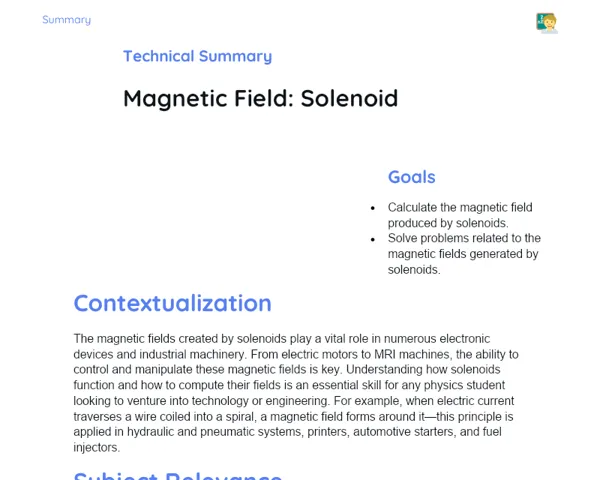Summary Tradisional | Waves: Electromagnetic and Mechanical
Contextualization
Waves are a basic phenomenon in physics that we encounter in multiple forms in our everyday lives. From the sunlight that brightens our day to the sounds we enjoy, waves are crucial for transferring energy from one place to another without moving matter. They can travel through various materials, such as solids, liquids, and gases, or even in a vacuum, depending on the type of wave.
There are two primary types of waves: mechanical and electromagnetic. Mechanical waves, such as sound and seismic waves, need a material medium to propagate, transmitting energy through the particles of that medium. On the other hand, electromagnetic waves, like visible light, radio waves, and X-rays, can travel without a material medium, even in a vacuum. Understanding this difference is vital for comprehending how various waves operate and their applications, ranging from radio communication to medical imaging techniques like ultrasound.
To Remember!
Concept of Waves
Waves are disturbances that move through a medium or vacuum, carrying energy without moving matter. They are classified based on their propagation method and energy type. Key characteristics of waves include wavelength, the distance between two consecutive points in phase; frequency, the number of cycles executed by a wave in a second; amplitude, the wave height indicating the energy amount carried; and speed, which measures how fast the wave travels through a medium.
Wavelength is critical, as it influences various physical properties of waves, including their ability to interfere and diffract. Frequency and wavelength have an inverse relationship, while directly correlating to the energy carried by the wave—higher frequency waves transport more energy. A wave's amplitude pertains to the strength of the signal it carries. The speed at which waves propagate varies with both the wave type and the medium; for instance, sound waves travel faster in solids than in liquids or gases.
Waves may be classified as transverse or longitudinal. In transverse waves, like electromagnetic waves, medium particles move perpendicular to the wave direction. Conversely, in longitudinal waves, like sound waves, medium particles move in the same direction as the wave propagates. This differentiation is essential for grasping how various waves interact with their propagation medium and how they transmit energy.
-
Waves transport energy without carrying matter.
-
Wavelength, frequency, amplitude, and speed are core characteristics of waves.
-
Waves can be classified as transverse or longitudinal.
Mechanical Waves
Mechanical waves need a material medium to move, transferring energy through the medium's particles. Familiar examples include sound waves and seismic waves. Sound waves are vibrations that travel through air, water, and solids, enabling us to hear sound. The medium's particles vibrate parallel to the direction of wave propagation, forming compressions and rarefactions that carry sound energy.
Seismic waves, produced by tectonic activity, spread through the Earth. They are categorized into P waves (primary) and S waves (secondary). P waves are longitudinal and travel fastest, while S waves are transverse, moving more slowly but typically causing greater destruction. Studying these waves helps us understand the planet's internal structure and foresee earthquakes.
The energy conveyed by mechanical waves correlates with the medium's density and the wave's amplitude. In denser media, waves travel quicker with increased energy. Grasping mechanical waves is vital for many applications, including civil engineering, where knowledge of seismic waves is essential for constructing safer buildings.
-
Mechanical waves require a material medium to propagate.
-
Sound waves and seismic waves are notable examples.
-
The energy transferred hinges on the medium’s density and the amplitude.
Electromagnetic Waves
Electromagnetic waves do not need a material medium for propagation, enabling travel in a vacuum. They consist of alternating electric and magnetic fields that move perpendicular to each other and the wave direction. Examples include visible light, radio waves, microwaves, infrared, ultraviolet, X-rays, and gamma rays.
Visible light is the portion of the electromagnetic spectrum visible to the human eye, crucial for our sight. It is used in many technologies like lighting and optical devices. Radio waves facilitate wireless communications, including radio, TV, and mobile phones. Microwaves find utility in radar systems and cooking technologies.
X-rays and gamma rays feature high frequencies and energies, being utilized in medical and industrial fields for imaging and treatment. The capacity of electromagnetic waves to traverse a vacuum is fundamental for space communications and exploring outer space. Understanding these waves enables innovations in communication, medicine, and beyond.
-
Electromagnetic waves can travel through a vacuum.
-
Examples include visible light, radio waves, and X-rays.
-
They are made up of oscillating electric and magnetic fields.
Differences and Similarities between Mechanical and Electromagnetic Waves
The primary distinctions between mechanical and electromagnetic waves are their propagation medium and energy transfer method. Mechanical waves require a solid, liquid, or gas to propagate, while electromagnetic waves can move through a vacuum. Moreover, mechanical waves transfer energy through medium particles, whereas electromagnetic waves do so through oscillating electric and magnetic fields.
For example, mechanical waves, such as sound, travel faster in solid materials due to denser particle packing, while electromagnetic waves, like light, reach their peak speed in a vacuum where medium resistance is absent. The speed of mechanical waves depends on the medium’s elasticity and density, while for electromagnetic waves, it is governed by the vacuum's permittivity and permeability constants.
Despite these variances, both wave types share key characteristics like wavelength, frequency, amplitude, and speed, which are crucial in defining and understanding wave behavior, no matter the type. Recognizing these similarities and differences is significant for practical applications of wave concepts in fields such as communication, medicine, and engineering.
-
Mechanical waves need a medium; electromagnetic waves can travel in a vacuum.
-
Mechanical waves transfer energy via particles; electromagnetic waves use oscillating fields.
-
Both wave types share characteristics like wavelength, frequency, amplitude, and speed.
Applications in Daily Life
Both mechanical and electromagnetic waves greatly impact our daily lives. Mechanical waves, such as sound waves, are essential for speech and music. Technologies like ultrasound rely on mechanical waves to create images of the body's interiors, widely employed in medical diagnostics and monitoring pregnancies.
Electromagnetic waves have even more extensive applications. Modern communication systems rely heavily on radio waves and microwaves for transmitting TV signals, radio broadcasts, and internet data. Visible light is key for vision and is utilized in devices like cameras, telescopes, and microscopes. X-rays are used in radiology for diagnosing fractures and other conditions, while gamma rays help in cancer treatments.
Additionally, infrared waves power remote controls and heat sensors, while ultraviolet light serves for sterilization and is found in fluorescent bulbs. Understanding wave properties facilitates the development of these essential technologies, which are vital for contemporary life and scientific progress.
-
Mechanical waves are crucial for communication, music, and ultrasound imaging.
-
Electromagnetic waves play roles in communication, lighting, medical diagnostics, and treatments.
-
Knowledge of waves fosters the creation of vital technologies.
Key Terms
-
Waves: Disturbances that carry energy through a medium or a vacuum.
-
Wavelength: Distance between two successive points in phase of a wave.
-
Frequency: Number of complete cycles performed by a wave in one second.
-
Amplitude: Height of a wave, symbolizing the quantity of energy transported.
-
Speed: Rate at which a wave travels through a medium.
-
Mechanical Waves: Must have a material medium to move.
-
Electromagnetic Waves: Can propagate in a vacuum without needing a material medium.
-
Sound Waves: Vibrations that travel through materials such as air, water, and solids.
-
Visible Light: Segment of the electromagnetic spectrum visible to the human eye.
-
Radio Waves: Employed in wireless communication, for instance, in radio and television.
-
X-rays: High-energy electromagnetic waves used for medical imaging.
-
Seismic Waves: Created by tectonic activities, travelling through the Earth.
Important Conclusions
In this lesson, we explored the core notion of waves, understanding their features and methods of propagation. We differentiated between mechanical and electromagnetic waves, identifying their unique characteristics and necessary propagation mediums. Mechanical waves like sound and seismic waves need a material medium, whereas electromagnetic waves such as visible light and radio waves can traverse a vacuum.
We also discussed their real-life applications, from radio and television transmissions to medical diagnostics using ultrasound and X-rays. Waves are integral to various technologies we encounter, essential for advancements in fields like medicine, engineering, and communication. Knowing about these waves enables us to foster and improve these technologies, enhancing our lifestyle and broadening our scientific understanding.
Finally, we underlined the significance of grasping these concepts to apply them in practical scenarios and tackle daily challenges. Awareness of waves and their attributes is paramount in many sectors, and further exploration of this topic may unveil opportunities for fresh discoveries and technological breakthroughs. We urge everyone to delve deeper into the study of waves, seeking further knowledge and engaging in practical examples.
Study Tips
-
Revise the ideas around wavelength, frequency, amplitude, and speed, applying practical instances to grasp their uses.
-
Seek out supplementary materials, like videos and online simulations, demonstrating mechanical and electromagnetic wave propagation in diverse media.
-
Perform simple experiments at home, such as crafting waves on a string or observing wave movement in water, to visualize the discussed concepts.



